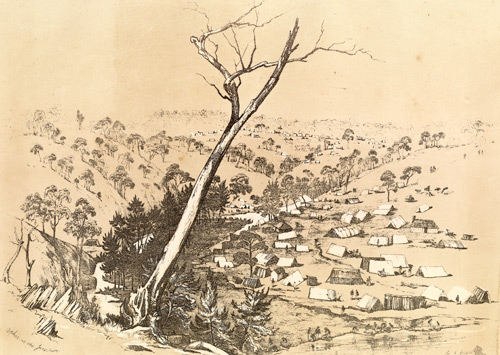Off to the Diggings: the gold rush
The Gold Country: compiled from official records and from the valuable information kindly afforded to the compiler by Mr E.H. Hargraves the Disoverer [sic] of the Gold Country, 1851 by William Meadows Brownrigg
Map, M4 812.2/gbfe/1851/1
Successfully drumming up enthusiasm for gold in the west, Hargraves set about publicising it via articles in the Sydney Morning Herald and holding court at Bathurst, lecturing and explaining techniques for gold mining.
Colonial geologist Samuel Stutchbury travelled to Ophir to confirm gold finds for the government. In his report to Governor FitzRoy on 19 May he wrote:
'gold has been obtained in considerable quantity…the number of persons engaged at work and about the diggings…cannot be less than 400 and of all classes.' Governor FitzRoy despatches, May 1851.
He apologised for his report being written in pencil, '…as there is no ink yet in this city of Ophir.'

A General view of Ophir, 1851, by George French Angas
Lithograph, PX*D 243/4
The government declared a gold discovery on May 22, 1851.
The government feared that the entire labouring class would abandon their duties in Sydney as clerks, labourers and servants failed to appear for work as thousands rushed west for the newly named "Ophir" gold field.
There was a concern that shepherds, drovers and farmers would abandon the developing agricultural industries that had been prospering the young colony. Governor FitzRoy wrote to Earl Grey on 29 May reporting that:
'thousands of people of every class are proceeding to the locality, - tradesmen and mechanics deserting certain and lucrative employment for the chance of success in digging for gold, - so that the population of Sydney has visibly diminished.' Governor FitzRoy despatches, May 1851.
Pastoralist James Macarthur suggested that martial law be introduced to prevent complete chaos. However the news spread of Hargraves' discovery and it was impossible for the government to stop the flow of people westwards. The one conversation around Sydney was, 'Have you been?' or 'Have your servants run yet?'
Sydney shopkeepers, canny in their ability to turn a profit and create consumer demand, began to fill their windows with all manner of miner’s wares. Blue and red serge shirts, 'real gold-digging gloves', mining boots, blankets and other camping goods became staple items. The newspapers were filled with advertisements for items to take to the gold fields.
On the roads to the diggings, all classes of people travelled with their belongings. There was an atmosphere of excitement and impending wealth. Eye-witness, Godfrey Charles Mundy, a soldier and writer saw:
'..sixty drays and carts, heavily laden, proceeding westward with tents, rockers, flour, tea, sugar, mining tools, etc. each accompanied by from four to eight men, half of whom bore fire-arms. Some looked eager and impatient, some half-ashamed of their errant, others sad and thoughtful, all resolved.'
By the end of May 1851, hundreds of diggers had arrived in the Ophir region and had begun their search for gold.
> Read Surveyor-General Sir Thomas Mitchell's diary of his travels to the goldfields
> What was life really like on the gold fields?


